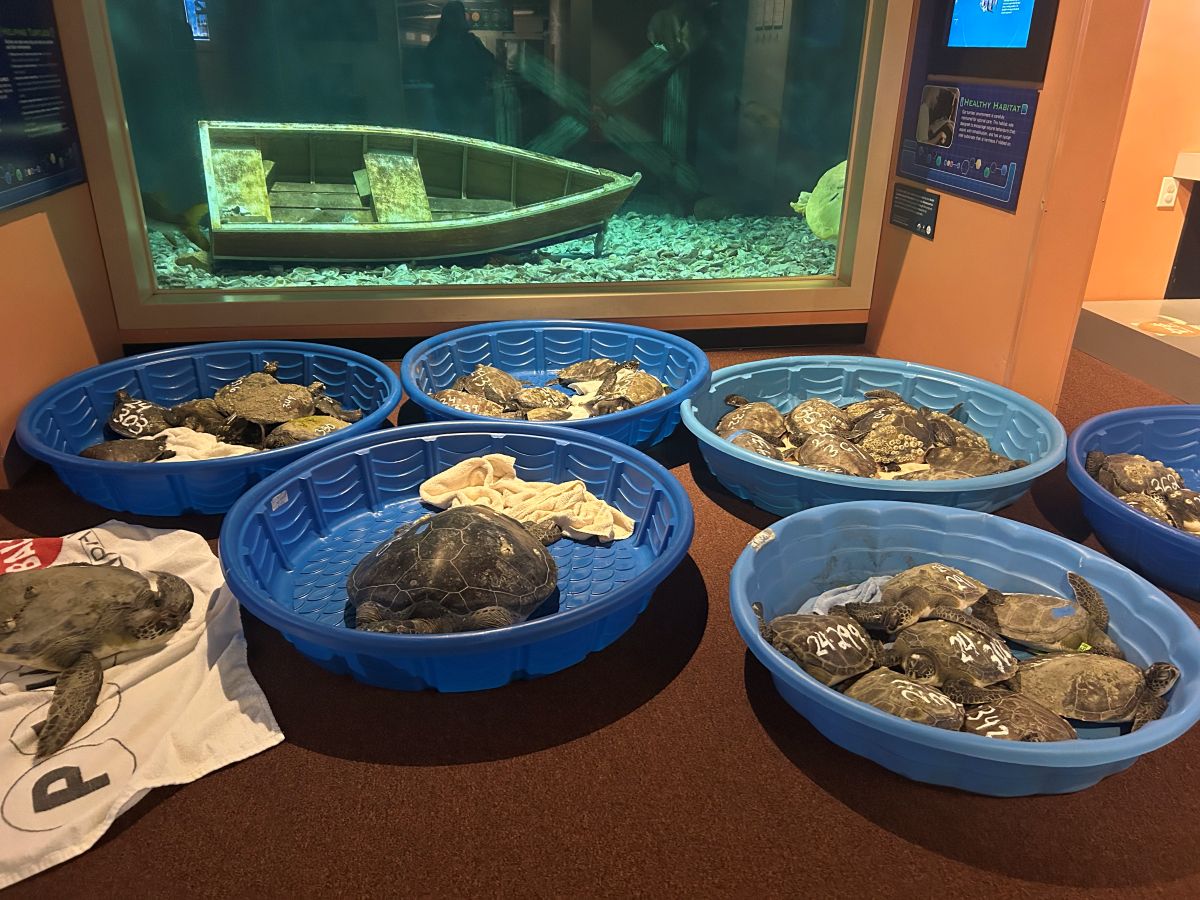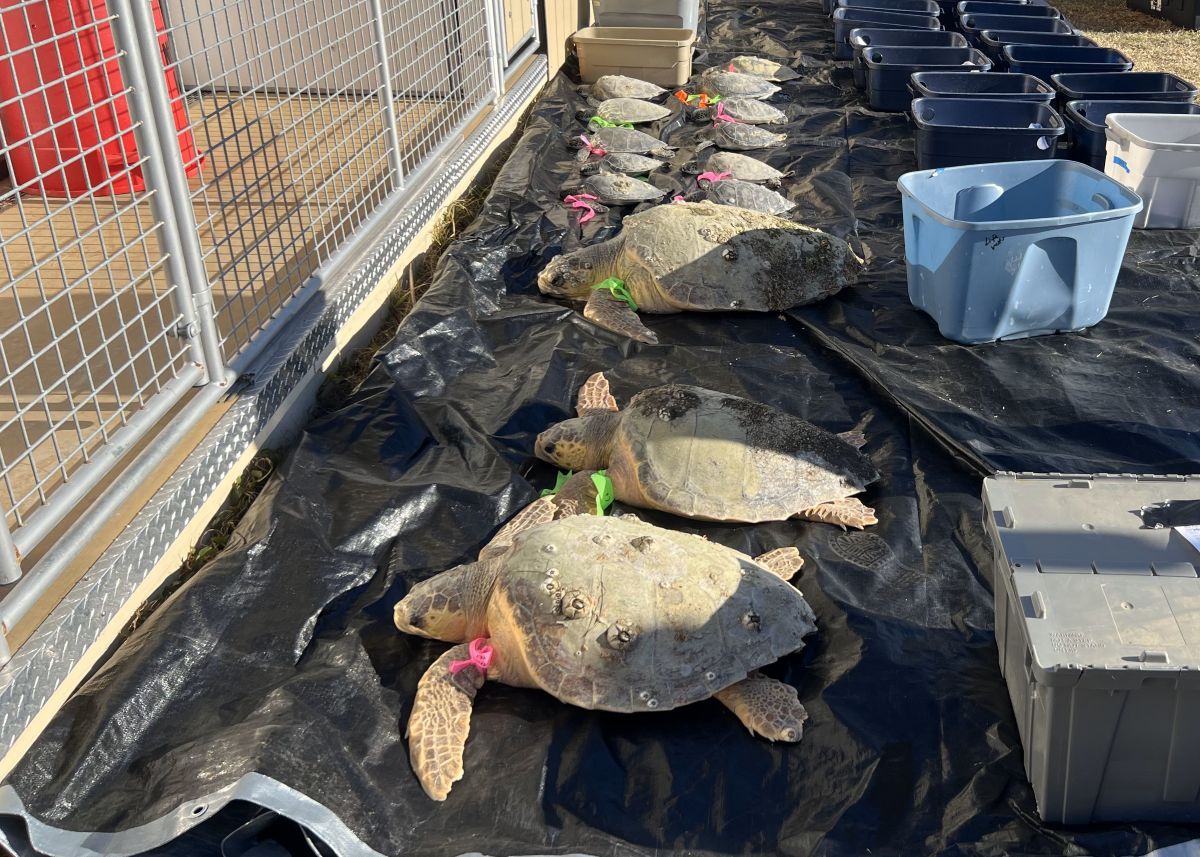
The hundreds of cold-stunned sea turtles that washed ashore after temperatures fell earlier this month on the Outer Banks have been given a second chance.
Over the last few weeks, staff at the Sea Turtle Assistance and Rehabilitation, or STAR, Center at the North Carolina Aquarium on Roanoke Island have been caring for close to 600 sea turtles that were cold stunned, which happens when water temperatures quickly drop before sea turtles can migrate to warmer water. Cold stunning can lead to death if not treated.
Supporter Spotlight
The Roanoke aquarium’s Animal Husbandry Curator Leslie Vegas told Coastal Review Thursday that most of the sea turtles are rescued in the Pamlico Sound. They enter the sound through inlets because they are foraging for food in the subaquatic vegetation, or seagrass, beds. A few wash up on the ocean side, but the vast majority are rescued from the sound.
Vegas is among the more than 135 aquarium staff and volunteers to care for the 553 cold-stunned sea turtles delivered to the aquarium between Dec. 1 and Dec. 7.
As of Dec. 17, the aquarium had received 576 sea turtles including the state’s most common species, the loggerhead, green and Kemp’s ridley, according to the aquarium.
“Because we are still ensuring our numbers are accurate, we don’t have exact species counts yet — and because the event is not technically over — but for this event so far, we have received approximately 580 turtles, with the most being 163 in one day,” Vegas said. So far, 399 turtles have been released as part of this event, some are being cared for at other facilities and about 50 arrived dead or died shortly after arrival.
As of Friday afternoon, the STAR Center was caring for 60 animals, and more releases were expected to take place in the coming weeks, Vegas said subsequently. With temperatures expected to drop again, aquarium staff are preparing for more cold-stunned turtles.
Supporter Spotlight
The North Carolina Wildlife Resources Commission manages the state’s sea turtles, which are protected under the federal Endangered Species Act.
“The great success in returning these turtles quickly to the wild is due to the combined efforts of many different volunteers and collaborators with the NCWRC Sea Turtle Project,” Commission biologist Matthew Godfrey said.
More than 20 different sea turtle project groups along the coast help monitor sea turtle nesting and stranding activities along the coast, including the Network for Endangered Sea Turtles, or N.E.S.T, the National Park Service, North Carolina Aquariums, the College of Veterinary Medicine at N.C. State University, the Coast Guard, the National Oceanic and Atmospheric Administration’s National Marine Fisheries Service, and the Karen Beasley Sea Turtle Rescue and Rehabilitation Center.
For this recent cold-stunned event, aquarium staff, the STAR Center, and N.E.S.T. volunteers worked with Cape Hatteras National Seashore, the Wildlife Resources Commission, the Outer Banks SPCA, area veterinarian clinics, Phideaux fishing vessel, and the U.S. Coast Guard Stations at Hatteras Inlet and Fort Macon worked together to care for and release the sea turtles.

“Sea turtles are important to coastal ecosystems,” and because sea turtles are endangered species, any efforts to protect them are important, Vegas said.
Green sea turtles use sea grass beds as feeding grounds and they eat the subaquatic vegetation itself. “Just like plants on land, the SAVs and sea grass beds require ‘maintenance’ and ‘pruning,’ which the sea turtles provide. Without that maintenance, it’s possible that those beds would suffer enough damage to not thrive,” Vegas said.
Sea turtles use oceanic coastal shorelines to nest and lay eggs and these nests provide stabilization and nutrients to an ecosystem that is often nutrient depleted. These nutrients support the minimal plant life that exists on dunes, which also aid in shoreline stabilization, she continued.
Vegas explained that cold stuns occur naturally.
“If the decrease in temperature is gradual, the turtles will naturally migrate to southern waters, but if there’s a rapid decrease, the turtles miss the environmental cue to migrate, and the stunning event occurs,” she said.
Sea turtles are exothermic and they cannot regulate their own body temperatures. When the temperature drops, typically below 50 degrees Fahrenheit, the sea turtles become weak and lethargic, sometimes appearing deceased due to their extreme inactivity and lethargy. The turtles usually float to the water’s surface and from there, winds, tides or both can wash the turtles onto the shore, she added. Cold-stun events have been documented since the 1800s, and because it is not preventable, the response to these events is human intervention and rehabilitation to rescue as many as possible.
When temperatures drop, “our partners with the Network for Endangered Sea Turtles, the National Park Service, and N.C. Wildlife Resources Commission scout the soundside shore for turtles and transport them to us at the aquarium,” Vegas said.
NEST Director Jerrica Rea told Coastal Review that the volunteer-run nonprofit organization is thankful for partners in the NPS, ferry system and aquarium.
“Without the collective work from everyone, managing an event like this would not be possible,’ Rea said.
During the cold-stun season that takes place from December to around March, NEST volunteers patrol the soundside waters of Hatteras Island looking for sea turtles.
“We monitor different things like wind direction and water temperature to determine when the turtles may start to struggle. Sea turtles will generally migrate to warmer waters as our water cools in winter but occasionally we will have a perfect storm like this event,” Rea said, referring to the cold-stunning from earlier this month.
The sea turtles are typically juveniles who are content to feed in sound waters and don’t get the cue to leave when the temperature goes from warm to cold quickly. The sudden drop in temperature and the prolonged nature of it led to NEST finding over 560 sea turtles in one week.
Those turtles are taken to a staging site in Buxton where NEST volunteers take measurements, photos and document them, Rea said. They are then transported to STAR center at the aquarium, a more than 100-mile round trip ride.

“As an all volunteer organization, we are extremely proud of the efforts from our cold stun team. They work in the worst conditions-rain, snow, wind and freezing temperatures. We have over 20 patrol responders, 50 staging site volunteers and many more transporters,” Rea said. “The dedication our volunteers have to rescuing sea turtles is indescribable. It’s an honor to be part of such an incredible team and to see the community come together to help this endangered species.”
Turtle triage, treatment
Once the turtle arrives at the aquarium, staff administer fluid therapy since the turtles have likely been exposed and may have become dehydrated while stunned.
The length, width and weight of each sea turtle is recorded as well as any abnormalities or injuries. Blood work determines if there are nutritional or other deficiencies, like organ impairment. Because their organs are not functioning optimally while stunned, additional medication is not typically dispensed until they are gradually brought to healthy, warm temperatures, Vegas explained.
Bringing sea turtles up to the right temperature cannot happen fast, either. For this process, the turtles are moved to different sections of the aquarium, each set at a slightly warmer temperature, to ensure that the warming is gradual.
The Roanoke Island aquarium uses an incident command system and emergency response in the form of triage, like how humans are triaged in emergency care, to rehabilitate the sea turtles.

“We split the turtles up based on the level of care necessary to release them, as well as by species and size. Some species can be housed together and some cannot. In an event this large, those that are most likely to survive are prioritized to maximize our number of turtles released,” Vegas said. “We provide supportive care to those with more complicated medical issues until we can devote more time to them, after healthier turtles are released.”
The sea turtles that only needed to be warmed up were released within two to four days of rescue. “The more complicated medical cases could be here for weeks or months depending on their rate of progress and the care they may require,” Vegas said.
“If the individual turtle has additional medical needs, we keep the turtle in house for treatment, to go through the full rehabilitation process that addresses their specific medical needs,” Vegas added, but if no other health issues are identified beyond cold stunning, the turtles are released to the Gulf Stream as quickly as possible after they are at temperature, their bloodwork is cleared by veterinary staff, and they exhibit normal sea turtle behaviors.
“The releases are made possible through our relationship with the U.S. Coast Guard at Cape Hatteras, who are kind enough to transport our turtles to the Gulf Stream,” Vegas said.
The incident command system ensures that all departments within the aquarium are engaged to provide excellent turtle care and supportive care for humans,” Vegas said.
“This event involved many partners and staff, and that has been the highlight of it all for me. Seeing the dedication and teamwork that was fostered, along with the animals that were saved, are the things we are most proud to share,” Vegas said.
Sea turtles that appear still or sluggish in the sound water or on a beach during winter months should not be pushed back into the water or moved. Report any turtles under duress to the Sea Turtle Stranding Hotline via N.E.S.T. at 252-441-8622.
The N.C. Aquarium on Roanoke Island operates under the N.C. Wildlife Resources Commission’s Sea Turtle Permit No. 24ST46.
Coastal Review will not publish Tuesday, Wednesday and Thursday in observance of the Christmas holiday.








